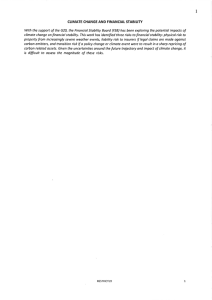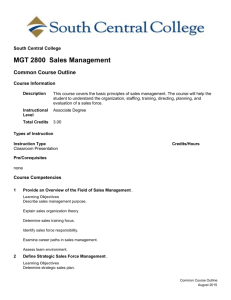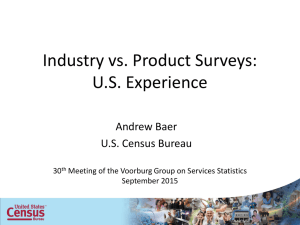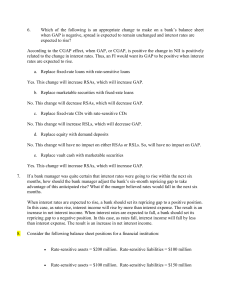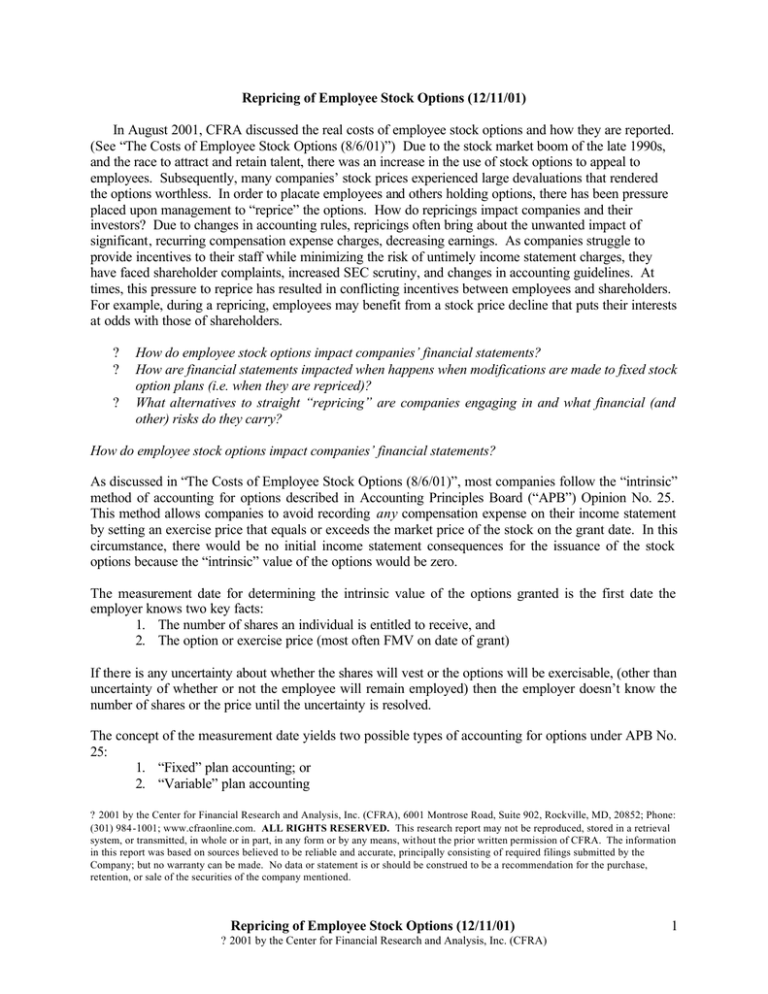
Repricing of Employee Stock Options (12/11/01)
In August 2001, CFRA discussed the real costs of employee stock options and how they are reported.
(See “The Costs of Employee Stock Options (8/6/01)”) Due to the stock market boom of the late 1990s,
and the race to attract and retain talent, there was an increase in the use of stock options to appeal to
employees. Subsequently, many companies’ stock prices experienced large devaluations that rendered
the options worthless. In order to placate employees and others holding options, there has been pressure
placed upon management to “reprice” the options. How do repricings impact companies and their
investors? Due to changes in accounting rules, repricings often bring about the unwanted impact of
significant, recurring compensation expense charges, decreasing earnings. As companies struggle to
provide incentives to their staff while minimizing the risk of untimely income statement charges, they
have faced shareholder complaints, increased SEC scrutiny, and changes in accounting guidelines. At
times, this pressure to reprice has resulted in conflicting incentives between employees and shareholders.
For example, during a repricing, employees may benefit from a stock price decline that puts their interests
at odds with those of shareholders.
?
?
?
How do employee stock options impact companies’ financial statements?
How are financial statements impacted when happens when modifications are made to fixed stock
option plans (i.e. when they are repriced)?
What alternatives to straight “repricing” are companies engaging in and what financial (and
other) risks do they carry?
How do employee stock options impact companies’ financial statements?
As discussed in “The Costs of Employee Stock Options (8/6/01)”, most companies follow the “intrinsic”
method of accounting for options described in Accounting Principles Board (“APB”) Opinion No. 25.
This method allows companies to avoid recording any compensation expense on their income statement
by setting an exercise price that equals or exceeds the market price of the stock on the grant date. In this
circumstance, there would be no initial income statement consequences for the issuance of the stock
options because the “intrinsic” value of the options would be zero.
The measurement date for determining the intrinsic value of the options granted is the first date the
employer knows two key facts:
1. The number of shares an individual is entitled to receive, and
2. The option or exercise price (most often FMV on date of grant)
If there is any uncertainty about whether the shares will vest or the options will be exercisable, (other than
uncertainty of whether or not the employee will remain employed) then the employer doesn’t know the
number of shares or the price until the uncertainty is resolved.
The concept of the measurement date yields two possible types of accounting for options under APB No.
25:
1. “Fixed” plan accounting; or
2. “Variable” plan accounting
? 2001 by the Center for Financial Research and Analysis, Inc. (CFRA), 6001 Montrose Road, Suite 902, Rockville, MD, 20852; Phone:
(301) 984-1001; www.cfraonline.com. ALL RIGHTS RESERVED. This research report may not be reproduced, stored in a retrieval
system, or transmitted, in whole or in part, in any form or by any means, wit hout the prior written permission of CFRA. The information
in this report was based on sources believed to be reliable and accurate, principally consisting of required filings submitted by the
Company; but no warranty can be made. No data or statement is or should be construed to be a recommendation for the purchase,
retention, or sale of the securities of the company mentioned.
Repricing of Employee Stock Options (12/11/01)
? 2001 by the Center for Financial Research and Analysis, Inc. (CFRA)
1
Fixed plan accounting is appropriate if the employer knows the answers to the two questions above prior
to the issuing of the options. With fixed accounting, the total compensation expense (zero if the exercise
price is equals the market price of the stock on the grant date) is fixed on the grant date. This expense is
recognized on the company’s income statement over time as the options vest.
Variable plan accounting is appropriate if there is uncertainty about whether the shares will vest or the
options will be exercisable such that the employer cannot answer the two questions posed above prior to
the grant date. Under variable accounting, the total compensation expense is estimated on the date of
grant but it is remeasured at the close of each reporting period based upon the best guess as to the
resolution of the contingency. This approach is similar to a “mark-to-market” concept, with the income
statement potentially impacted each reporting period. The direction and magnitude of this recurring item
can vary greatly.
To summarize, the distinction between fixed plan accounting and variable plan accounting is important
because fixed plan accounting results in little to no compensation expense recording on the income
statement each period whereas variable plan accounting causes compensation expense to be recorded on
the income statement each and every reporting period.
How are financial statements impacted when happens when modifications are made to fixed stock option
plans (i.e. when they are repriced)?
As discussed in APB 25 and clarified in FASB Interpretation (“FIN”) No. 44, three modifications can be
made to a fixed stock option:
1. Extend or decrease the life of the option
2. Modify the exercise or purchase price of the option (known as “repricing”)
3. Change the number of shares the grantee is entitled to receive
According to FIN 44, which was released in March, 2000 and applies retroactively to December 15, 1998,
any changes to the life of the option or number of shares granted results in a new measurement of
compensation cost as if the option were newly granted but does not mandate variable accounting.
However, any direct (or indirect) changes to the exercise price (“repricing”) of the option results in a
mandatory change from fixed to variable accounting for the option. Sometimes a company issues new
options during the vesting period for previously issued options. In determining whether an indirect
change to the exercise price of the old options was effected by the new options, the FASB requires the
company to look back six months from the date a stock option is cancelled to determine if there were any
options granted at a lower exercise price within the six months; if so, these options would be subject to
variable accounting. Look-forward provisions are also discussed. The provisions in FIN No. 44 which
require variable accounting with the ramifications discussed above have significantly reduced the number
of outright “repricings” which have occurred since the December 15, 1998 cut-off date 1 .
1
According to the National Center for Employee Ownership’s (NCEO) 2000 NCEO Broad-Based Stock Option
Survey:
•In 1998, 36% of surveyed companies had repriced their options within the past three years
•In 2000, only 30% repriced within three years and only 7.5% repriced since the December 15, 1998 cut-off date
Repricing of Employee Stock Options (12/11/01)
? 2001 by the Center for Financial Research and Analysis, Inc. (CFRA)
2
What alternatives to straight “repricing” are companies engaging in and what financial (and other) risks
do they carry?
FIN 44 does not require variable accounting for the following alternative approaches that reduce the
exercise price of an outstanding stock option:
1. Cancel existing options and issue new options at least six months later (commonly referred to as
“6&1”)
2. Issue new options and leave existing options outstanding
3. Cancel existing options and issue restricted stock (options with an exercise price of $0)
Accounting considerations of “6&1”: This approach occurs when the company cancels the existing
underwater options and issues new option awards six month and one day later with an exercise price
equal to the fair market value of the stock on the date of grant. This approach ostensibly avoids the
lookback provisions of FIN 44 but may still trigger variable accounting if the following conditions are not
met:
1. The company cannot offer to cancel stock options in exchange for a promise to issue new stock
options after a certain period. If it does, variable accounting will be triggered on the options to be
cancelled.
2. Employees must be exposed to market risk during the six months that elapse between cancellation
and regrant.
3. Employees must give up any recently granted stock options with lower option prices, in addition
to giving up underwater stock options.
Additionally, employees have an incentive for the stock price to decrease during this six-month interval,
which puts them at odds with shareholder interests.
Accounting considerations of issuing new options and leaving existing options outstanding: This
approach is employed when a company issues new options at fair market value while leaving existing
underwater options outstanding. The old options may be subsequently cancelled six months after the
issuance of the new options. However, variable accounting will be required if the following conditions
are not met:
1. To avoid variable accounting, the recipient of the new grant must have no knowledge of the
subsequent cancellation
2. Because they would have knowledge of the subsequent cancellation, executives and members of
the board of directors should not be included in this repricing alternative
3. Variable accounting will be required for the new grant at the grant date of the new option if there
is an agreement - actual or implied – to surrender existing options
Accounting considerations of canceling existing options and issuing restricted stock: Restricted stock
grant is, in effect, an option with an exercise price of $0; therefore, variable accounting is not required
because future reductions in the exercise price are not possible. However, a fixed compensation charge is
measured at the date the restricted shares are granted, equal to the fair value of the stock on the grant date.
Compensation cost must be recorded over the vesting period in which the restrictions lapse.
Repricing of Employee Stock Options (12/11/01)
? 2001 by the Center for Financial Research and Analysis, Inc. (CFRA)
3




